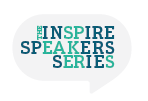
In November, Dr. Wallace J. Nichols (“J”) traveled to Pittsburgh from California’s slow coast to present at GBA’s monthly Inspire Speakers Series. The following day, he joined participants of our School Sustainability Culture Program (a program of the Green & Healthy Schools Academy) to discuss how K-12 educators, administrators, and facility managers could use his research to create healthy, high-performing, sustainable, and inspiring places to learn.
The School Sustainability Culture Program is a two-year immersive learning community that helps schools integrate sustainability into their buildings, curriculum, and entire culture. Participants attend the Inspire Speakers Series lectures and corresponding monthly workshops with our speakers, and have regularly assigned homework. The topic of J’s presentation – and his recent best-selling book – was Blue Mind, a study of the connections between water and neuroscience. Nichols himself assigned the participants’ homework for December. He argues that the scientific community has for the most part shunned any connection between emotions and science. Neuroconservation challenges that notion, and aims to explore the relationship between our emotions, our brain, and our environment. To help stimulate this type of thinking, J asked the workshop participants to think about which emotions might have caused the negative environmental impacts we’re experiencing now, and which emotions might be applied to fixing it. He then asked them to select one of those emotions and take a deep dive into the neuroscience of that emotion. At December’s workshop, participants were asked to share the emotions they had researched. Here are some responses, including how each emotion can be connected back to the K-12 community.
EMPATHY
Google Definition: The ability to understand and share the feelings of another.
Origin: From the Greek term empatheia (“in feeling”)

Research Findings and Reflections:
- There is emerging research about how you can actually teach empathy – through things like literature and even video games – because those media can really put you in someone else’s position.
- A very effective way to teach empathy can be through foreign language, because you need to be patient and listen to your classmates, and give them time to work through their pronunciation – and they need to do the same for you.
Connections Drawn from the Group:
- How are we asking our students to demonstrate what they know? If they can demonstrate what they’ve learned, there is a problem-solving aspect which can also bring great discomfort, and therefore lead to re-training the brain and developing a certain level of empathy.
COMPASSION
Google Definition: Sympathetic pity and concern for the sufferings or misfortunes of others.
Origin: From the Latin term compati (“suffer with”)
Research Findings and Reflections:
- This is the emotional response when someone perceives suffering. It can even be a survival mechanism, and in fact the desire to help – or compassion – can positively impact your physical and mental health.
Connections Drawn from the Group:
- Compassion can be developed through an authentic connection to something or someone, and this is similar to empathy. As educators, we attempt to create these experiences for our students.
AWE
Google Definition: A feeling of reverential respect mixed with fear or wonder.
Origin: From the Old English term ege (“terror, dread, awe”)
Research Findings and Reflections:
- Awe has a profoundly positive impact on people. Because of awe, people act more generously, think more critically, and direct more of their concern towards others (this ties to compassion and empathy).
- Approximately 70% of awe is inspired by nature.
- Question from the group: Is awe always positive, or can it also be negative? The words awesome and awful both come from the same root. And people can be in awe of nature in both positive and negative ways. For example, a surfer could be in awe of a great wave, but we can also be in awe of natural disasters and the damage they inflict.
Connections Drawn from the Group:
- In the classroom, we try to present topics in ways that are awe-inspiring because the students become more invested in those projects. But that is something that you have to carefully plan for, and it takes a lot of time. When planning a lesson or a unit, we often ask ourselves: “Is this going to be awesome?”

UNCERTAINTY
Google Definition: The state of being uncertain; doubt; hesitancy.
Origin: The Middle English term uncerteynte (un-certainty)
Research Findings and Reflections:
- When someone is faced with many choices, they can be paralyzed with uncertainty, fear, and discomfort, not allowing them to move forward. (Fear and discomfort are related to uncertainty, and it was noted that a certain level of discomfort can also accompany empathy).
Connections Drawn from the Group:
- Regarding sustainability, teaching our students with a level of fear can be overwhelming and make them feel there is nothing they can do to make a change. Instead, we should work to act as models, showing them what we are doing now – and what they can do (now and in the future) – to make the challenge more manageable.
Following this compelling conversation, GBA’s Jenna Cramer and ECS’s Nikole Sheaffer led the group in an activity about meeting people where they are in terms of sustainability. Quoting Interface’s George Bandy and Jim Hartzfeld, there are 100 doors into sustainability, and everyone’s door is different. A lot of those doors are opened by emotions like those we researched above. If you are interested in learning more about neuroscience, nature, and emotion, check out Dr. Nichols’ website. Meanwhile, stay tuned for more about the Green & Healthy Schools Academy and its School Sustainability Culture Program! Check out photos from our November and December workshops, too!
